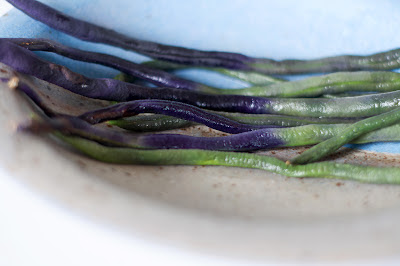As you will recall the original purpose of the allotment visit was to pick black beans.
When they start growing they are wonderfully curly, but eventually straighten out, and that is when you pick them.
Of course you have already noticed the papilionaceous flower shape, haven't you?
The advantage of growing these beans in your vegetable patch is not only that they look exotic thus encouraging your neighbours to think you are some kind of gourmand, but they provide the extra fun of changing colour when cooked.
Uncooked
Cooking
Half Cooked
So what is going on, where has the purpley-black colour gone? Let me explain ...
The dark colour is made of pigments called Anthocyanins (Greek: anthos = flower; kyanos = blue). These give colour to leaves, fruits, and flowers, though the final colour may be in the red spectrum not just blue. Cherries, blueberries, blackberries, wild rice, blood oranges are all examples of fruits high in anthocyanins.
Back to the beans - the dark colour disappears when cooked because the pigments break down when heated to 84C, allowing the green chlorophyll, that was always there underneath, to appear.
Another twist in the tale is that the blue colour fades in alkaline conditions. When the bean is heated some internal cells burst and release sap which is alkaline. So the anthocyanins are doomed.
This made me wonder what would happen if the beans were soaked in an acidic solution, so I dashed back into the kitchen, rescued the now limp and dully green beans, and put them in a dish of lemon juice. And, ta da, the patches that hadn't cooked and were still purple perked up into a nice inky colour. You can't really see it in these photos but trust me, there was a little bit of magic.








